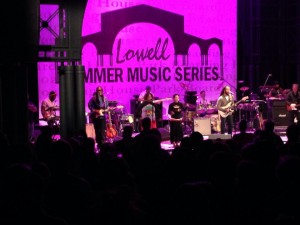Lowell Summer Music Series @ 25 Years
Following is an excerpt from the chapter “Telling the Story” in my forthcoming book Mill Power: The Origin and Impact of Lowell National Historical Park (Rowman & Littlefield, 2014), which is set for release this fall. I’m sharing this in the spirit of opening night, last night, of the Lowell Summer Music Series, which is marking its 25th season this year. The Series opened with an outstanding performance by Ziggy Marley and friends last night that transfused the overflowing audience with good vibes. Everyone was swaying and bouncing and singing along with the buoyant music-makers.—PM
iPhone-photo by Rosemary Noon
.
Each summer since 1989, a beautiful park that was once a rundown parking lot turns the middle of Lowell into one of the most exciting performance venues in Massachusetts. The weekend evening concerts and daytime free shows for kids bring more than 30,000 people to the front of the pavilion that is the trademark of the Lowell Summer Music Series, a partnership of LNHP and the Lowell Festival Foundation. What is the National Park Service doing managing a pop music series, even one with a traditional arts twist? What began as a modest attempt to liven up the Park and Preservation District and stimulate tourist activity has become one of the city’s cultural cornerstones, not as massive as the Folk Festival because of the limitations of the downtown green, which holds about 2,000 people comfortably.
What is really going on from the Park Service’s perspective, however, is that music and dance are the media for relating to people and inviting them into the historic district, where they learn about what the NPS does in Lowell. When the stars appear over the iconic Boott Cotton Mills clock-and-bell tower, the audience gets a postcard view of a national park vista. When Ziggy Marley shouts out his father’s words, “Get up, Stand up, Stand up for your rights!” against the red-brick backdrop of the mill, and the entire audience shouts those words with him, it’s not a big leap to imagine the mill girls “turning-out” to protest a 20 percent cut in pay in 1834. They fought for their rights.
.
from Mill Power: The Origin and Impact of Lowell National Historical Park by Paul Marion
